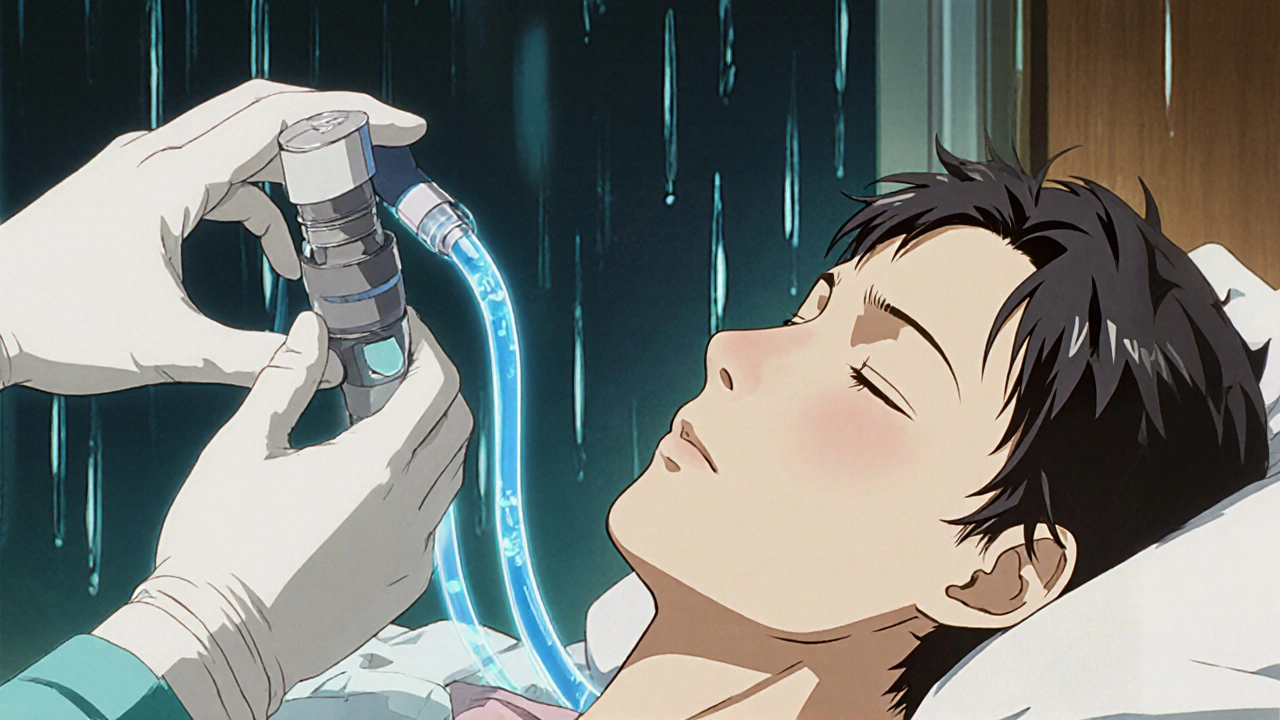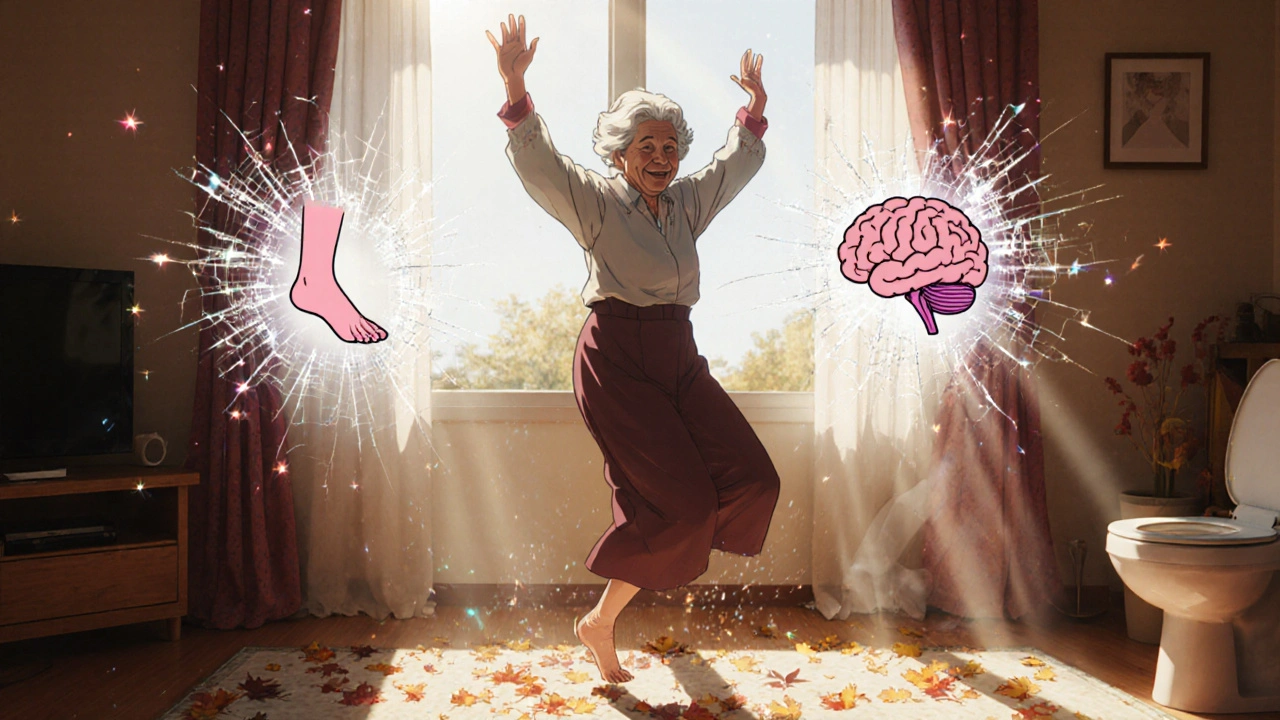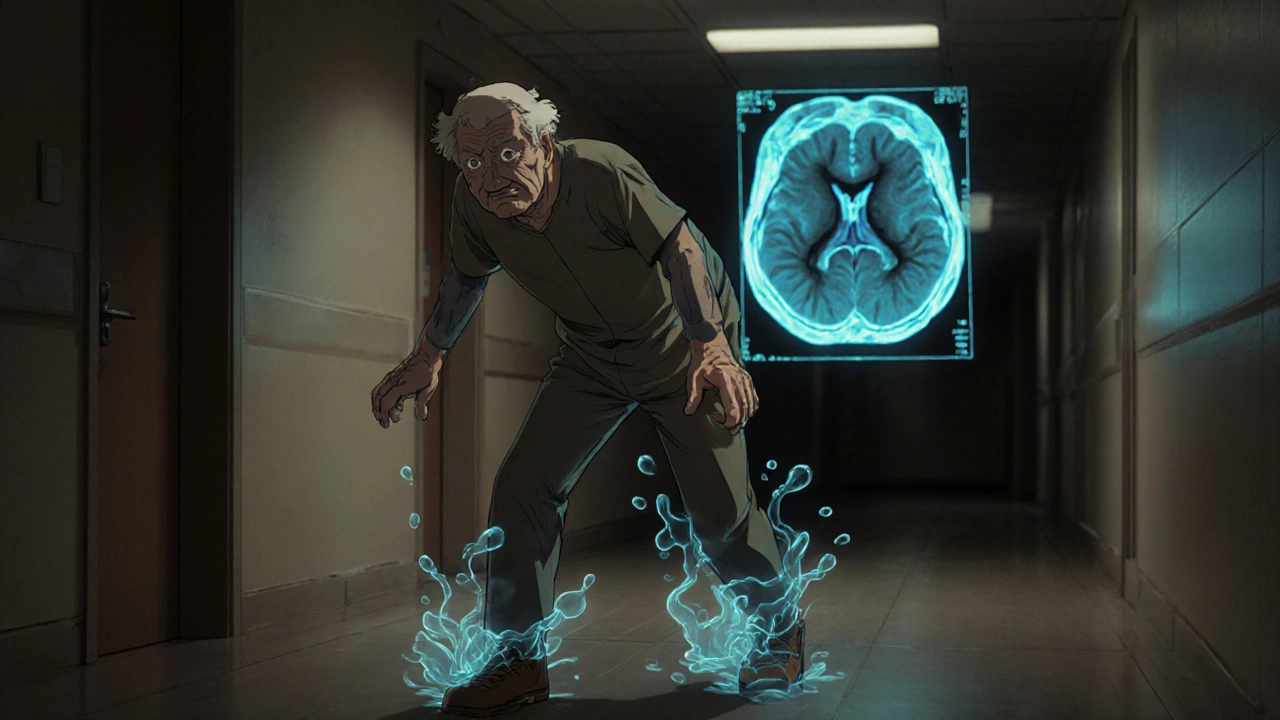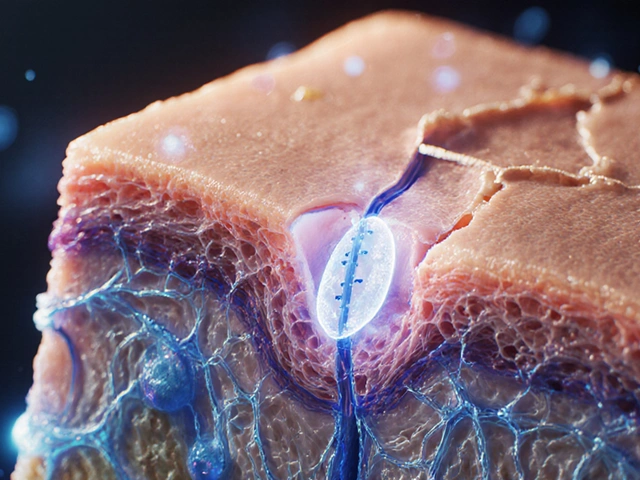Normal Pressure Hydrocephalus, or NPH, isn’t something most people have heard of-until it starts affecting someone they know. It’s not Alzheimer’s. It’s not Parkinson’s. But it can look like both. And here’s the thing: if caught early, it’s one of the few types of dementia that can be reversed. That’s not a guess. That’s what doctors see in the operating room and in follow-up scans.
What Exactly Is Normal Pressure Hydrocephalus?
NPH happens when too much cerebrospinal fluid (CSF) builds up in the brain’s ventricles. These are natural fluid-filled spaces, but when they swell, they press on surrounding brain tissue. The catch? The pressure stays within the normal range-70 to 245 mm H₂O. That’s why it’s called normal pressure. It’s misleading. The fluid is there, the brain is compressed, and symptoms creep in slowly.
This condition almost always shows up after age 60. In fact, about 1 in 200 people over 65 have it. Among nursing home residents, that number jumps to nearly 6%. Yet, most are misdiagnosed. A 2022 study in the Journal of Neurology, Neurosurgery & Psychiatry found that up to 60% of NPH cases are mistaken for other brain conditions. That’s not just a diagnostic error-it’s a missed chance to restore someone’s independence.
The Three Signs: Gait, Cognition, and Bladder Control
NPH doesn’t come with one symptom. It comes with three-and they don’t always show up together. But when they do, the pattern is unmistakable.
- Gait disturbance: This is the first and most consistent sign. People don’t just walk slower. They shuffle. Their feet seem stuck to the floor. It’s called a “magnetic gait.” You’ve seen it-someone lifts their knees barely enough to move forward, arms held out for balance, wide stance. In a Mayo Clinic study of diagnosed patients, 100% had this symptom. It’s not weakness. It’s not stiffness. It’s the brain’s signal to walk getting drowned out by fluid pressure.
- Cognitive impairment: Memory loss? Maybe. But it’s not like Alzheimer’s. In NPH, it’s more about slow thinking, trouble focusing, losing track of conversations, or forgetting why you walked into a room. Neuropsychological tests show clear deficits in executive function-planning, organizing, decision-making. About 73% of patients show these signs. The frontal lobes, responsible for these tasks, are the ones being squished.
- Urinary incontinence: This often comes last. People don’t suddenly lose control. They start needing to go more often, then have accidents. By the time this shows up, the condition has been progressing for months, sometimes years. Only about a third of patients have this symptom at diagnosis, but it’s a red flag when paired with gait and thinking problems.
Only about 29% of people have all three. That’s why doctors miss it. If someone has trouble walking and a little forgetfulness, they’re told, “It’s just aging.” But aging doesn’t make your feet feel glued to the floor.
How Is It Diagnosed? It’s Not Just a Scan
Getting diagnosed with NPH isn’t as simple as a CT scan and a nod. You need a full picture.
First, imaging. A brain MRI or CT shows enlarged ventricles. The key measurement is Evan’s index-when the ventricles take up more than 30% of the brain’s width, that’s a red flag. But here’s the twist: many older adults have slightly enlarged ventricles from normal aging. So size alone doesn’t confirm NPH.
Then comes the CSF tap test. A doctor removes 30 to 50 milliliters of spinal fluid with a needle in the lower back. Not a lot-about two shot glasses. Then, they measure how the patient walks before and after. If walking speed improves by 10% or more, or if balance gets noticeably better, that’s a strong predictor. A 2022 Cleveland Clinic study found this test predicts shunt success with 82% accuracy.
Some centers use external lumbar drainage-where a catheter is left in the spine for a few days to drain fluid continuously. That’s more accurate but more invasive. Still, it’s worth it if the tap test is borderline.
And don’t forget cognitive testing. Tests like the Trail Making Test Part B and Digit Symbol Substitution Test measure processing speed and mental flexibility. NPH patients score low here-not because their memory is gone, but because their brain can’t process information quickly anymore.

Shunt Surgery: The Only Treatment That Works
If the diagnosis is confirmed, the only effective treatment is surgery: a ventriculoperitoneal (VP) shunt. It’s not brain surgery in the scary sense. It’s a two-catheter system. One goes from the brain’s ventricle, down the neck and chest, into the abdomen. The other ends in the belly, where the extra fluid gets absorbed like any other waste.
The valve between them is set to open at a specific pressure-usually between 50 and 200 mm H₂O. Some valves are programmable. That means a doctor can adjust the pressure non-invasively with a magnet, outside the body. No extra surgery needed.
The procedure takes about an hour. Hospital stay? Usually 3 to 4 days. Recovery takes weeks. But the changes can be sudden.
One patient on Reddit, a 72-year-old man, wrote: “After my shunt, my 10-meter walk dropped from 28 seconds to 12 seconds-in less than two days. I hadn’t been able to go to the bathroom on my own in 18 months. That was gone too.”
Studies show 70 to 90% of properly selected patients improve. But “properly selected” is key. If you don’t have a clear gait improvement after the tap test, the shunt might not help. And that’s why some patients don’t benefit-up to 30% in some studies.
Why Some Shunts Don’t Work
Not every shunt works. And not every patient should get one.
Shunt failure happens in 15% of cases within two years. Infections occur in about 8.5% of patients. Subdural hematomas-bleeding between the brain and skull-happen in 5.7%. These risks are higher in people over 80.
But the bigger issue is timing. Dr. George T. Chi from Massachusetts General Hospital says: “Delay beyond 12 months from symptom onset reduces surgical efficacy by 30%.” That means if you wait too long, the brain tissue gets permanently damaged. The fluid pressure has been there too long. Even if you drain it, the brain doesn’t bounce back.
And here’s another twist: many patients have mixed dementia. They have NPH and early Alzheimer’s. That happens in 25 to 30% of cases. The shunt helps the NPH part-the gait, the bladder control, some of the thinking-but not the Alzheimer’s. That’s why some people feel better, but not “fixed.”

What Happens After Surgery?
Recovery isn’t instant. You need follow-ups. At two weeks, six weeks, three months, and six months. The valve might need adjusting. Some patients need a second surgery to change the pressure setting. That’s normal.
Long-term, 68% of patients still show improvement 20 years after surgery, according to Sweden’s national registry. But shunts don’t last forever. The average lifespan before needing a revision is just over six years. That’s why NPH patients often need lifelong neurosurgical care.
And the emotional side? A 2022 Hydrocephalus Association survey of 457 patients found 89% were satisfied with their treatment-even though 32% needed at least one shunt revision. They regained independence. They stopped needing help to walk. They could go to the bathroom alone again. That’s not just medical success. That’s life-changing.
Why So Many Cases Are Missed
Here’s the hard truth: NPH is underdiagnosed because it’s not taught well in medical schools. Primary care doctors see an elderly patient with a slow walk and mild memory issues. They order a memory test. It’s “borderline.” They say, “It’s dementia.” They don’t think to check for CSF buildup.
Insurance doesn’t help either. A 2022 American Medical Association survey found that 37% of patients had their CSF tap test denied by insurance before approval. Some insurers won’t cover the test unless the patient has already been diagnosed with dementia. That’s backwards. The test is how you diagnose it.
And then there’s the stigma. “Old people walk slowly. They forget things. It’s normal.” But it’s not normal. It’s treatable.
Dr. Norman Relkin from Weill Cornell Medicine calls NPH “the great masquerader of geriatric neurology.” He’s right. It hides in plain sight.
What’s New in NPH Research?
There’s hope on the horizon.
In 2022, the FDA approved a device called the Radionics® CSF Dynamics Analyzer. It measures how easily fluid drains from the brain-something no scan can do. This tool improves diagnostic accuracy to 89%.
A new app, the iNPH Diagnostic Calculator, uses 12 clinical factors to predict shunt success with 85% accuracy. It’s being used in clinics across Europe and the U.S.
And researchers are testing blood and spinal fluid biomarkers. Three Phase II trials are underway, looking for protein patterns that signal NPH. Early results show 92% sensitivity. If this works, we could diagnose NPH with a simple blood test-no spinal tap needed.
For now, though, the best tool is awareness. If an older adult starts walking differently, forgets why they walked into a room, or has trouble holding their bladder-don’t assume it’s aging. Ask: Could this be NPH?
Because if it is, there’s a chance to turn back the clock. One shunt. One surgery. One chance to walk again, think clearly, and live independently.







swatantra kumar
November 19, 2025 AT 20:37Rebecca Cosenza
November 20, 2025 AT 09:45Bill Camp
November 21, 2025 AT 15:13Sarah Swiatek
November 23, 2025 AT 08:49Dave Wooldridge
November 24, 2025 AT 19:00robert cardy solano
November 24, 2025 AT 19:33Rusty Thomas
November 26, 2025 AT 07:30Pawan Jamwal
November 27, 2025 AT 16:35Cinkoon Marketing
November 29, 2025 AT 04:08rob lafata
November 30, 2025 AT 13:05Lemmy Coco
November 30, 2025 AT 15:54serge jane
December 1, 2025 AT 07:25Nick Naylor
December 2, 2025 AT 10:15Matthew McCraney
December 4, 2025 AT 04:46